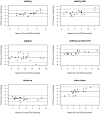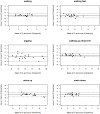Validation and comparison of two methods to assess human energy expenditure during free-living activities
- PMID: 24587401
- PMCID: PMC3938775
- DOI: 10.1371/journal.pone.0090606
Validation and comparison of two methods to assess human energy expenditure during free-living activities
Abstract
Background: The measurement of activity energy expenditure (AEE) via accelerometry is the most commonly used objective method for assessing human daily physical activity and has gained increasing importance in the medical, sports and psychological science research in recent years.
Objective: The purpose of this study was to determine which of the following procedures is more accurate to determine the energy cost during the most common everyday life activities; a single regression or an activity based approach. For this we used a device that utilizes single regression models (GT3X, ActiGraph Manufacturing Technology Inc., FL., USA) and a device using activity-dependent calculation models (move II, movisens GmbH, Karlsruhe, Germany).
Material and methods: Nineteen adults (11 male, 8 female; 30.4±9.0 years) wore the activity monitors attached to the waist and a portable indirect calorimeter (IC) as reference measure for AEE while performing several typical daily activities. The accuracy of the two devices for estimating AEE was assessed as the mean differences between their output and the reference and evaluated using Bland-Altman analysis.
Results: The GT3X overestimated the AEE of walking (GT3X minus reference, 1.26 kcal/min), walking fast (1.72 kcal/min), walking up-/downhill (1.45 kcal/min) and walking upstairs (1.92 kcal/min) and underestimated the AEE of jogging (-1.30 kcal/min) and walking upstairs (-2.46 kcal/min). The errors for move II were smaller than those for GT3X for all activities. The move II overestimated AEE of walking (move II minus reference, 0.21 kcal/min), walking up-/downhill (0.06 kcal/min) and stair walking (upstairs: 0.13 kcal/min; downstairs: 0.29 kcal/min) and underestimated AEE of walking fast (-0.11 kcal/min) and jogging (-0.93 kcal/min).
Conclusions: Our data suggest that the activity monitor using activity-dependent calculation models is more appropriate for predicting AEE in daily life than the activity monitor using a single regression model.
Conflict of interest statement
Figures


References
Publication types
MeSH terms
LinkOut - more resources
Full Text Sources
Other Literature Sources
Medical

